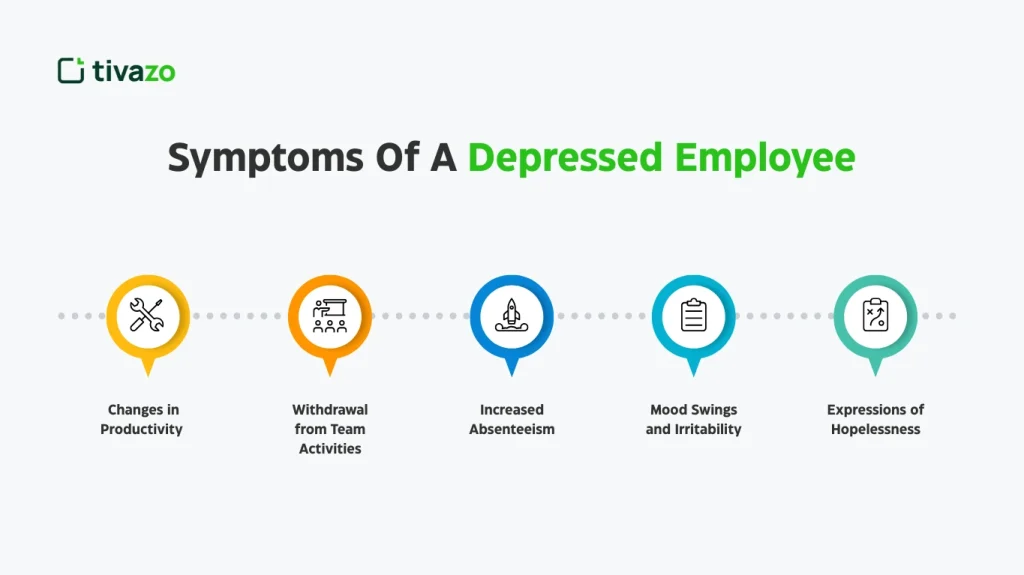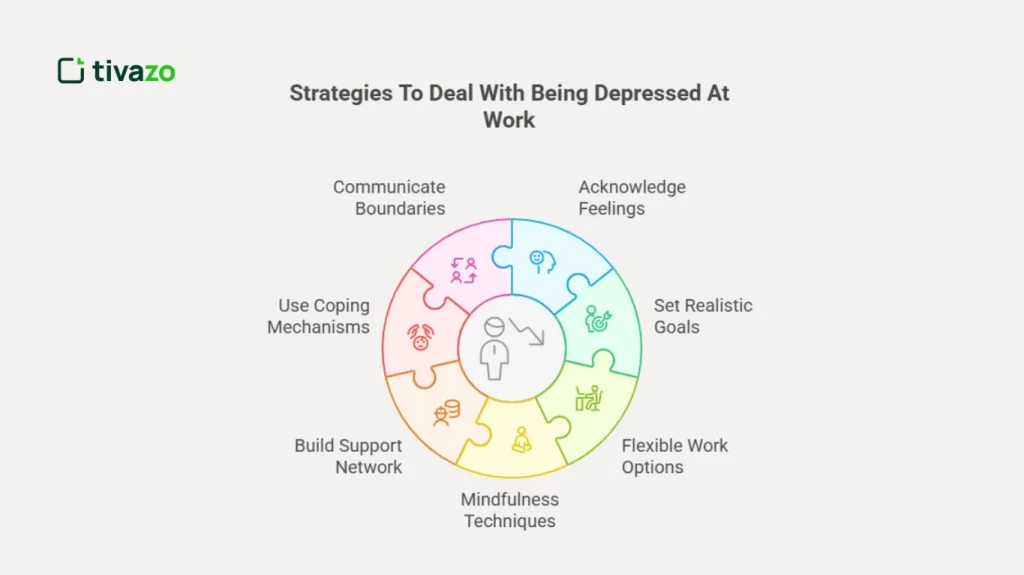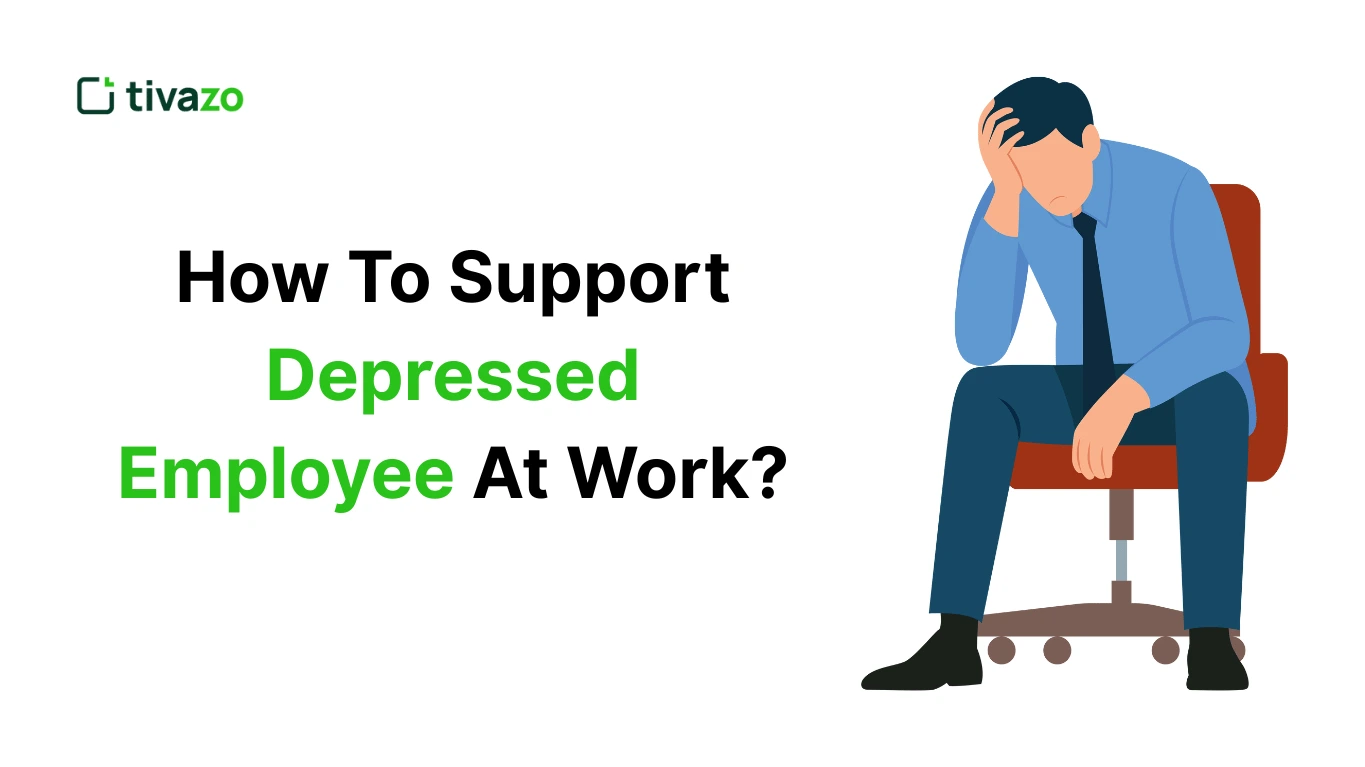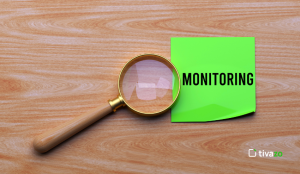Depression can manifest as silence in meetings, missed deadlines, or a once-outstanding employee suddenly isolating themselves, rather than always seeming like sadness. It’s more crucial than ever in today’s fast-moving businesses to spot someone who might be having problems.
Supporting a depressed employee entails more than just being nice; it’s about creating a resilient, compassionate workplace where everyone feels secure, heard, and appreciated. Ignoring the symptoms of workplace depression can result in burnout, disengagement, and high turnover as employee mental health becomes an increasing problem.
Through evidence-based solutions, this blog discusses how you might spot depression’s symptoms at work and offer significant support. Whether you’re an HR professional, team lead, or manager, you’ll find seven smart ways to help staff members with depression and advance better mental health at work while also raising morale, output, and trust throughout your company.
Key Highlights:
- Symptoms of a depressed employee
- 7 ways to deal with depression at work
- How Addressing The Depressed Employee Benefits The Workplace?
What are the symptoms of a depressed employee?
The first step in providing real help is identifying the symptoms of a depressed employee. Many workers quietly suffer, concerned about consequences or criticism. That’s why managers, HR teams, and even colleagues need to understand what to look for.
Watch for these most often seen indications of a depressed employee:

1. Changes in Productivity and Focus
A discernible drop in an employee’s performance is a serious red flag. Tasks that were once straightforward might take more time now, and awareness of detail might diminish. Missed deadlines, subpar work, or an inability to finish projects can all show this.
Often impacting concentration, memory, and energy—the main drivers of workplace productivity—depression. Don’t believe laziness or disinterest if a previously dependable employee unexpectedly finds their job challenging. It might point to problems with mental health at work.
Assisting staff members with depression entails acknowledging that, frequently, they cannot control production changes. Instead of penalizing poor performance, start a private, sympathetic discussion to learn what they might be struggling with.
2. Withdrawal from Coworkers or Team Activities
One of the most often seen behavioral signs of depression on the job is isolation. Once, outgoing staff members could start avoiding team lunches, skipping meetings, or switching their camera off during virtual calls.
Often a coping mechanism, this withdrawal isn’t rudeness. Interacting with others can be too much when someone is battling their mental health at work. You could also observe less interaction in conversations or less desire for teamwork.
Providing emotional support for employees comprises noticing these patterns and softly checking in. Establishing a helping workplace in which staff members don’t feel compelled to fake it will enable them to feel secure enough to open up.
3. Increased Absenteeism or Unexplained Sick Days
Regular skipping of work or turning up late may indicate that such a worker is fighting personal problems. Depression related absenteeism is usually mistaken as absenteeism because one is not serious enough; better still, it may be a manifestation that they might be exhausted mentally and emotionally.
In other instances, a depressed employee would be more likely to call in sick or under some unconvincing excuses not to go to work at all. It may also be due to chronic fatigue, bad sleep and stress, and anxiety-related physical manifestations.
To deal with this, it is worth revisiting the HR policies that address mental health and introducing some possibilities to provide flexibility and mental health days. Utilize the services of the Employee Assistance Program (EAP), where possible, and tell them that being vulnerable does not mean that someone is weak.
4. Mood Swings and Irritability
Depression is not necessarily a sad state, but also the irritableness or sudden mood swings. When an employee is in depression, he or she can appear to be unusually moody, short-tempered, irritated, or easily emotional on trivial matters.
This vulnerability of emotions can be seen as the consequence of inner struggle against anxiety, despair, or invasion by an overwhelming stress. It has the potential to worsen relationships with colleagues and managers, creating a false impression in case it is not addressed accordingly.
The realization that mood swings can be signs of underlying depression leads people to think in a more sympathetic way instead of punishment and rejection. The important step is to create an atmosphere in which employees feel free to share their feelings.
5. Expressions of Hopelessness or Low Self-Esteem
Depressed feelings at work workplace may be signified by verbal or non-verbal low self-esteem. The employee can, at some point, complain about his/her own inabilities, trivialize achievements, or appear excessively critical of themselves.
Expressions such as I am not good enough or I can not keep up, may be a not-so-obvious call to aid. Such remarks have an influence on motivation and participation, which has overall effects on the morale of the workplace.
Such negative feelings may be combated by encouraging positive reinforcement and emotional support. It will also lead to staff feeling like they can trust their managers more as they learn how to recognize and respond to the above signs, which will improve the mental health of employees.
It is important to identify these symptoms as being empathetic towards them rather than judging them. Be it productivity and mental health problems, withdrawn emotions, or more stress-related absences, once the warning signs are identified, there is an opportunity to assist depressed employees better and create a healthier place of work with more understanding.
How to deal with being depressed at work? (7 Smart Ways)

Working and coping with depression can be daunting, but still, you can still balance out your mental well-being and work-related tasks with appropriate approaches. Be it a depressed employee or a manager seeking to assist a depressed one, knowing how to manage the situation is the key element of staying productive and well. The following are 7 intelligent ideas in dealing with being depressed at work that facilitate healing, balance, and support.
1. Acknowledge Your Feelings and Seek Help
The initial process of coping with depression in the workplace is by accepting and being honest about what you are feeling. Refusal or concealment of disorders aggravates the state and builds pressure in the workplace. There is no shame in saying that you are not doing fine; on the contrary, it is a source of strength.
Leading with a trusted manager, HR person, or mental health provider can be discussed. Employee Assistance Program (EAP) is offered by many companies and is a confidential entity that helps with counseling resources. Early help could help you avoid burnout and have a better life at both personal and professional levels.
It is important to remember that mental health is crucial to maintain at the workplace, not only for you but also for the whole team.
2. Set Realistic Goals and Prioritize Tasks
Depression also makes ordinary duties so challenging. Set realistic expectations for yourself and cut your work into small and achievable blocks.
To tackle tasks in order of priority and urgency. To eliminate the disorganization, you should use tools such as to-do lists or digital planners. Acknowledge small victories, however small they may be, and they accumulate power and self-esteem.
This will help you reduce stress and become more productive since you now have a way of prioritizing and doing what is possible, and this will influence your state of mind and enhance your experience at work.
You May Also Like: SMART Framework for Goal Setting theory: Achieve Success
3. Take Advantage of Flexible Work Options
Most organizations have come to appreciate the need to help employees have a favorable working environment through introducing flexibility. Look at alternative beneficial practices, such as remote work, flexi-time, or mental illness days, in case you can, to help more control your energy.
Flexibility also reduces stress and anxiety at the place of work since when a person feels ready to work, he/she does it. It will also allow him some room to do some self-care routines throughout the day or even attend a therapy session.
Discuss these with your supervisor- most employers would be happy to oblige, provided you take the initiative and are forthcoming in communication.
4. Practice Mindfulness and Stress-Relief Techniques
The symptoms of depression can be considerably reduced at the workplace by introducing such mindfulness strategies as deep breathing, meditation, or short walks.
Such methods can make you feel balanced, decrease stress, and increase your focus. A couple of minutes of concentrated breathing will flip your switch when you are having a bad day.
Most work environments have started providing wellness programs, or any place where you can take a walk to relax- use such facilities to take out some time for yourself and make your mind feel more relaxed.
You May Also Like: Effective 6 Stress Management Techniques Today
5. Build a Support Network at Work
You do not need to do this on your own. Emotional support during difficult times can be established by creating relationships with confidence through trusted colleagues or managers.
Candid discussions about mental health in the workplace remove the stigma barrier and establish a mental health-friendly environment where staff members should not be afraid to talk about their problems.
Whenever there is mental health awareness training going on in your workplace, be active; training will enable you and others to help each other in a better way.
6. Use Coping Mechanisms That Work for You
No one can tell the story of depression resemblance. Learn and create a habit to adopt coping measures that make sense to you, it could be journals, sports, music, or artistic activities.
The activities not only help you to lighten up but also enhance resilience and allow you to manage work pressure.
Adding personal coping skills to your day-to-day practice is an effective method of dealing with symptoms and remaining productive.
You May Also Like: 10 Interpersonal Skills in the Workplace To Master in 2025
7. Communicate Boundaries and Practice Self-Compassion
Depression requires close limits that need to be observed between work and personal life. Do not over-commit and do more once you are tired.
Master how to say no with a nice voice and guard your energy. Self-compassion is also recommended: try not to forget that sometimes it is legitimate to be on a bad day and that recuperation passes through stages.
Be kind to yourself, ask for help when you need it, and when it comes to health, never forget that taking care of yourself is good both to the individual and the work environment.
All these 7 smart ways to cope with being a depressed employee will allow you to manage your situation with more confidence and strength. Mental health is not only a way of taking better care of yourself, but it changes everything you do.
How Addressing The Depressed Employee Benefits The Workplace?

It is not only a humane thing to support a depressed employee but also a shrewd decision that would benefit the workplace significantly as a whole. As organizations engage in a proactive response to the mental well-being of their employees by identifying issues and addressing them when a worker goes through depression at the workplace, organizations are able to create a favourable and productive working environment that encourages productivity and employee engagement. A World Health Organization study has shown that depression and anxiety cost the global economy an estimated one trillion dollars annually in lost productivity, indicating the importance of mental health support in the success of any business.
In addition, treating depression is useful in decreasing depression absenteeism and presenteeism, or working but mentally absent. According to research published by Harvard Business Review, employees with proper mental health support are 4.6 times more inclined to remain at their work and exhibit a greater degree of satisfaction towards their employment. When organizations employ successful HR policies on mental health and establish a healthy environment at the workplace, they not only enhance the health of the individual but also bolster the team performance and group dynamics in the workplace.
Last but not least, increasing open discussions and access to services such as employee assistance programs (EAP) and mental health awareness training will help to de-stigmatise mental health at the workplace. This candid will make the employees approach them very early, and this may curb the progression of the symptoms and even chronic disability. The investment in mental health is an investment in a strong and dedicated workforce; the workforce that can adapt, innovate, and continue to work even during the tough times.
Are You Experiencing Workplace Depression?
Sometimes, depression can creep in unnoticed. Use this simple self-check to reflect on your current state. If you answer “yes” to several of these questions, you might be experiencing workplace depression, and it’s important to seek support.
Ask Yourself:
- Do I feel emotionally exhausted most days at work?
- Have I lost interest in tasks I once enjoyed?
- Do I often feel worthless or unmotivated at work?
- Am I withdrawing from coworkers or avoiding social interaction?
- Do I struggle to concentrate or complete basic tasks?
- Have I been taking more sick days or showing up late frequently?
- Do I feel irritable, anxious, or hopeless during the workday?
If several answers are “yes,” consider speaking with your manager, HR, or accessing your Employee Assistance Program (EAP). You are not alone, and help is available.
Remember: Early intervention can prevent burnout and improve your overall mental health at work.
Burnout vs Depression: What’s the Difference?
Many people confuse burnout with depression, but while they can overlap, they are distinct conditions. Here’s a clear comparison to help you (and your team) better understand the differences:
| Symptom | Burnout | Depression |
| Cause | Work-related stress or overload | Complex—can be work-related, personal, or biological |
| Mood | Frustrated, cynical, detached | Hopeless, sad, empty, low self-worth |
| Motivation | Still care deep down but feel too exhausted | Often lose interest in everything |
| Energy | Physical exhaustion that may improve with rest | Persistent fatigue that doesn’t go away with rest |
| Scope | Usually limited to work | Affects all areas of life |
| Solution | Time off, workload balance, rest | Still care deep down, but feel too exhausted |
Conclusion
Supporting a depressed employee is crucial for fostering a healthy, productive workplace. Recognizing signs of depression in the workplace and offering resources like employee assistance programs (EAP) helps improve employee mental health and reduce absenteeism due to depression.
By promoting open conversations and mental health awareness training, companies can break the stigma around mental health at work and build a truly supportive work environment. Taking these steps benefits both employees and the organization, creating a culture where everyone can thrive.
FAQ’s
What to say to a depressed employee?
“I’ve noticed some changes and wanted to check in. I’m here if you need support.” Speak privately, listen without judgment, and offer resources.
How to deal with an employee with mental health issues?
Be empathetic, ensure confidentiality, offer flexibility, and connect them with HR or mental health resources like EAP.
How to tell if an employee is struggling?
Look for signs like poor focus, absenteeism, isolation, mood swings, or low motivation. Gently check in and offer support.




